Generation Change in Agriculture: A Systematic Review of the Literature
Abstract
1. Introduction
2. Methodology
3. Results
3.1. Barriers to Generational Change
3.2. Family Factor in Generational Change
3.3. Education and Knowledge Transfer
3.4. Urban Migration of Young People
3.5. Digitalization and Modern Farming Practices
3.6. Sustainability and Climate Change
3.7. High Administrative Burdens, Low Income of Farmers, and a Weak Bargaining Position
3.8. Land Mobility
3.9. Supporting Measures and Main Barriers to Generational Change
3.10. Policy Implications
4. Conclusions
Author Contributions
Funding
Informed Consent Statement
Data Availability Statement
Conflicts of Interest
| 1 | PRISMA stands for Preferred Reporting Items for Systematic Reviews and Meta-Analyses. It is an evidence-based minimum set of items for reporting in systematic reviews and meta-analyses. |
References
- Ariyo, Joseph Ayodele, and Michael Mortimore. 2012. Youth Farming and Nigeria’s Development Dilemma: The Shonga Experiment. Ids Bulletin 43: 58–66. [Google Scholar] [CrossRef]
- Bertolozzi-Caredio, Daniele, Isabel Bardaji, Isabeau Coopmans, Barbara Soriano, and Alberto Garrido. 2020. Key steps and dynamics of family farm succession in marginal extensive livestock farming. Journal of Rural Studies 76: 131–41. [Google Scholar] [CrossRef]
- Bosselmann, Aske Skovmand. 2012. Mediating factors of land use change among coffee farmers in a biological corridor. Ecological Economics 80: 79–88. [Google Scholar] [CrossRef]
- Brandth, Berit, and Grete Overrein. 2013. Resourcing Children in a Changing Rural Context: Fathering and Farm Succession in Two Generations of Farmers. Sociologia Ruralis 53: 95–111. [Google Scholar] [CrossRef]
- Buliga-Stefanescu, Aurelian, and Raluca Necula. 2018. The analysis of national programme for rural development measures and the evolution of agricultural holdings in the period 2007–2016 at the level of Olt county. Scientific Papers Series Management, Economic Engineering in Agriculture and Rural Development 18: 67–74. [Google Scholar]
- Chiswell, Hannah M. 2018. From Generation to Generation: Changing Dimensions of Intergenerational Farm Transfer. Sociologia Ruralis 58: 104–25. [Google Scholar] [CrossRef]
- Chiswell, Hannah M., and Matt Lobly. 2018. “It’s definitely a good time to Be a farmer”: Understanding the changing dynamics of successor creation in late modern society. Rural Sociology 83: 630–53. [Google Scholar] [CrossRef]
- Conway, Shane Francis, Maura Farrell, John McDonagh, and Anne Kinsella. 2020. Mobilising Land Mobility in the European Union: An Under-Researched Phenomenon. Available online: http://hdl.handle.net/11019/2504 (accessed on 15 December 2022).
- Coopmans, Isabeau, Joost Dessein, Francesco Accatino, Federico Antonioli, Camelia Gavrilescu, Piotr Gradziuk, Gordana Manevska-Tasevska, Miranda Meuwissen, Mariya Peneva, Bárbara Soriano, and et al. 2020. Policy directions to support generational renewal in European farming systems. Eurochoices 19: 30–36. [Google Scholar] [CrossRef]
- Csizmady, Adrienne, Bernadett Csurgó, Szabina Kerényi, András Balázs, Veronika Kocsis, and Botond Palaczki. 2021. Young Farmers’ Perceptions of Sustainability in a Wine Region in Hungary. Land 10: 815. [Google Scholar] [CrossRef]
- de Haan, Rachel, Helen Hambly Odame, Naresh Thevathasan, and Sarath Nissanka. 2020. Local Knowledge and Perspectives of Change in Homegardens: A Photovoice Study in Kandy District, Sri Lanka. Sustainability 12: 6866. [Google Scholar] [CrossRef]
- Dhanya, Praveen, Andimuthu Ramachandran, and Kandasamy Palanivelu. 2022. Understanding the Local Perception, Adaptation to Climate Change and Resilience Planning Among the Farmers of Semi-Arid Tracks of South India. Agricultural Research 11: 291–308. [Google Scholar] [CrossRef]
- Downey, Heather, Guinever Threlkeld, and Jeni Warburton. 2016. How do older Australian farming couples construct generativity across the life course?: A narrative exploration. Journal of Aging Studies 38: 57–69. [Google Scholar] [CrossRef] [PubMed]
- Downey, Heather, Guinever Threlkeld, and Jeni Warburton. 2017. What is the role of place identity in older farming couples’ retirement considerations? Journal of Rural Studies 50: 1–11. [Google Scholar] [CrossRef]
- Elahi, Ehsan, Zainab Khalid, and Zhixin Zhang. 2022. Understanding farmers’ intention and willingness to install renewable energy technology: A solution to reduce the environmental emissions of agriculture. Applied Energy 309: 118459. [Google Scholar] [CrossRef]
- European Commission. 2021. Available online: https://agriculture.ec.europa.eu/common-agricultural-policy/income-support/young-farmers_en (accessed on 25 January 2023).
- Farrell, Maura, Aisling Murtagh, Louise Weir, Shane Francis Conway, John McDonagh, and Marie Mahon. 2021. Irish Organics, Innovation and Farm Collaboration: A Pathway to Farm Viability and Generational Renewal. Sustainability 14: 93. [Google Scholar] [CrossRef]
- Firman, Achmad, Maman Paturochman, S. L. Budimulyati, M. H. Hadiana, D. Tasripin, Opan S. Suwartapradja, and M. Munandar. 2019. Succession decisions in Indonesia family dairy farm business. Livestock Research for Rural Development 31: 136. [Google Scholar]
- Galluzzo, Nicola. 2016. Interactions in Romanian agritourisms using a network analysis. Bulgarian Journal of Agricultural Science 22: 347–57. [Google Scholar]
- Gapuz, Cristeta, and Francisco Gapuz, Jr. 2013. Silk Technology Promotion and Commercialization: Corporate Social Responsibility Towards Livelihood Generation, Gender, Development and Climate Change Adaptation. Paper presented at International Conference on Management, Leadership & Governance, Bangkok, Thailand, February 7–8. [Google Scholar]
- Gkatsikos, Alexandros, Dimitrios Natos, Christos Staboulis, Konstadinos Mattas, Michail Tsagris, and Apostolos Polymeros. 2022. An Impact Assessment of the Young Farmers Scheme Policy on Regional Growth in Greece. Sustainability 14: 2882. [Google Scholar] [CrossRef]
- Guerra, Ana Isabel Nogueiro. 2018. Young Farmers as Innovation Enablers in Rural Areas: The Role of Eu’s Support in a Portuguese Peripheric Region, Trás-Os-Montes. Doctoral dissertation, Universidade de Lisboa, Lisboa, Portugal. [Google Scholar]
- Heider, Katharina, Juan Miguel Rodriguez Lopez, Andrea L. Balbo, and Jürgen Scheffran. 2021. The state of agricultural landscapes in the Mediterranean: Smallholder agriculture and land abandonment in terraced landscapes of the Ricote Valley, southeast Spain. Regional Environmental Change 21: 1–12. [Google Scholar] [CrossRef]
- HelpAge International. 2014. The Ageing of Rural Populations: Evidence on Older Farmers in Low- and Middle-Income Countries. Available online: https://www.helpage.org/silo/files/the-ageing-of-rural-populations-evidence-on-older-farmers-in-low-and-middleincome-countries.pdf (accessed on 25 January 2023).
- Jansuwan, Para, and Kerstin K. Zander. 2021. What to do with the farmland? Coping with ageing in rural Thailand. Journal of Rural Studies 81: 37–46. [Google Scholar] [CrossRef]
- Karttunen, Janne P., Risto H. Rautiainen, and Christina Lunner Kolstrup. 2016. Occupational Health and Safety of Finnish Dairy Farmers Using Automatic Milking Systems. Frontiers in Public Health 4: 147. [Google Scholar] [CrossRef] [PubMed]
- Koczberski, Gina, and George N. Curry. 2016. Changing Generational Values and New Masculinities Amongst Smallholder Export Cash Crop Producers in Papua New Guinea. The Asia Pacific Journal of Anthropology 17: 268–86. [Google Scholar] [CrossRef]
- Kondo, Chika. 2021. Re-energizing Japan’s teikei movement: Understanding intergenerational transitions of diverse economies. Journal of Agriculture, Food Systems, and Community Development 10: 103–21. [Google Scholar] [CrossRef]
- Korzenszky, Anna. 2019. Extrafamilial farm succession: An adaptive strategy contributing to the renewal of peasantries in Austria. Canadian Journal of Development Studies/Revue Canadienne D’études Du Développement 40: 291–308. [Google Scholar] [CrossRef]
- Lindsjö, Karin, Wapulumuka Mulwafu, Agnes Andersson Djurfeldt, and Miriam Kalanda Joshua. 2021. Generational dynamics of agricultural intensification in Malawi: Challenges for the youth and elderly smallholder farmers. International Journal of Agricultural Sustainability 19: 423–36. [Google Scholar] [CrossRef]
- Lorenzen, Rachel P., and Stephan Lorenzen. 2011. Changing Realities—Perspectives on Balinese Rice Cultivation. Human Ecology 39: 29–42. [Google Scholar] [CrossRef]
- Marcu, A. 2014. Increasing agricultural competitiveness by the setting up of young farmers. The case of Moldavia, Romania. Journal of Settlements and Spatial Planning 3: 117–23. [Google Scholar]
- Mariwah, Simon, Ruth Evans, and Kwabena Barima Antwi. 2019. Gendered and generational tensions in increased land commercialisation: Rural livelihood diversification, changing land use, and food security in Ghana’s Brong-Ahafo region. Geo: Geography and Environment 6: e00073. [Google Scholar] [CrossRef]
- Nainggolan, Mai Fernando, D. R. Nugraha, and Arjon Turnip. 2020. Empowering of Young Farmer for Arabica Coffee Farming Business in Simalungun. Iop Conference Series: Earth and Environmental Science 466: 012034. [Google Scholar] [CrossRef]
- Nemenyi, Agnes, and Ruth Rosser. 2010. Cultural and Ethnic Determinants of Land Use and Inheritance in Romania. Eastern European Countryside 16: 175–94. [Google Scholar] [CrossRef]
- Nipers, Aleksejs, and Irina Pilvere. 2020. Age Structure of Farm Owners and Managers: Problems and the Solutions Thereto in Latvia. Rural Sustainability Research 44: 15–26. [Google Scholar] [CrossRef]
- Osterhoudt, Sarah. 2018. Remembered resilience: Oral history narratives and community resilience in agroforestry systems. Renewable Agriculture and Food Systems 33: 252–55. [Google Scholar] [CrossRef]
- Pechrová, Marie Šimpachová, and Ondřej Simpach. 2018. Financial Support from EU’s Common Agricultural Policy for Young farmers in the Czech Republic. Paper presented at the International Conference on European Integration 2018, Ostrava, Czech Republic, May 17–18; pp. 1466–73. [Google Scholar]
- Pechrová, Marie Šimpachová, and Ondřej Simpach. 2020. Do the Subsidies Help the Young Farmers? The Case Study of the Czech Republic. Acta Universitatis Agriculturae Et Silviculturae Mendelianae Brunensis 68: 255–62. [Google Scholar] [CrossRef]
- Plana-Farran, Manel, and José Luis Gallizo. 2021. The Survival of Family Farms: Socioemotional Wealth (SEW) and Factors Affecting Intention to Continue the Business. Agriculture 11: 520. [Google Scholar] [CrossRef]
- Popa, Alina Mariana P., and Adrian Turek Rahoveanu. 2021. Supporting young farmers and the sustainability of rural regions. Case study-Olt county, Romania. Scientific Papers: Management, Economic Engineering in Agriculture & Rural Development 21: 651–57. [Google Scholar]
- Popescu, Gheorghe Cristian. 2019. Agricultural knowledge transfer: A case study for small farms and young farmers’ beneficiaries of European funds. Production Engineering Archives 25: 17–20. [Google Scholar] [CrossRef]
- Ramos, Guadalupe. 2005. The Continuity of Family Agriculture and the Succession System: The Basque Case. Journal of Comparative Family Studies 36: 367–75. [Google Scholar] [CrossRef]
- Scopus. 2022a. Available online: https://www.scopus.com/results/results.uri?sort=plf-f&src=s&st1=generation+renewal&st2=young+farmer&sid=f4d748baab5f783e43a517a095f58d35&sot=b&sdt=b&sl=67&s=%28TITLE-ABS-KEY%28generation+renewal%29+AND+TITLE-ABS-KEY%28young+farmer%29%29&origin=savedSearchNewOnly&txGid=a250defca8849e6ad250dc46722d3dd1 (accessed on 15 December 2022).
- Scopus. 2022b. Available online: https://www.scopus.com/results/results.uri?sort=plf-f&src=s&st1=generation+change&st2=young+farmer&sid=938111e778578814386d6b4a56d1e0c0&sot=b&sdt=cl&cluster=scolang%2c%22English%22%2ct%2bscosubtype%2c%22ar%22%2ct%2c%22cp%22%2ct&sl=66&s=%28TITLE-ABS-KEY%28generation+change%29+AND+TITLE-ABS-KEY%28young+farmer%29%29&origin=savedSearchNewOnly&txGid=7aa34f4200ee80e9ae90a684ffdaddc5 (accessed on 15 December 2022).
- Seck, Moussa, Moussa Na Abou Mamouda, and Salimata Wade. 2005. Adaptation and Mitigation Through “Produced Environments”: The Case for Agriculture Intensification in Senegal. Falmer: Institute of Development Studies. [Google Scholar]
- Shokeid, Moshe. 1990. Generations Divorced: The Mutation of Familism among Atlas Mountains Immigrants in Israel. Anthropological Quarterly 63: 76. [Google Scholar] [CrossRef]
- Simpach, Ondrej. 2017. Importance of Young Farmers in Selected Member States of European Union. Reprodukce lidského kapitálu–vzájemné vazby a souvislosti (RELIK 2017). pp. 446–53. Available online: http://www.ondrejsimpach.wz.cz/publikace/konference_CPCI_SCOPUS/RELIK_2017/Simpach_RELIK_2017.pdf (accessed on 15 December 2022).
- Šimpachová Pechrová, M., O. Šimpach, T. Medonos, D. Spěšná, and M. Delín. 2018. What are the motivation and barriers of young farmers to enter the sector? AGRIS On-Line Papers in Economics and Informatics 10: 79–87. [Google Scholar] [CrossRef]
- Sponte, Maria. 2014. The role of young farmers in the sustainable development of the agricutural sector. Calitatea 15: 410. [Google Scholar]
- St Aisyah, Ra, Darmawan Salman, Ahmad Ramadhan Siregar, and Syahdar Baba. 2020. Modernizing dairy farm: A production mode analysis. International Journal on Advanced Science Engineering Information Technology 10: 775–81. [Google Scholar]
- Steward, Angela. 2007. Nobody farms here anymore: Livelihood diversification in the Amazonian community of Carvão, a historical perspective. Agriculture and Human Values 24: 75–92. [Google Scholar] [CrossRef]
- Swindell, Kenneth. 2019. Faith, Work, Farming and Business: The Role of the Spiritual in West African Livelihoods. Journal of Asian and African Studies 54: 819–37. [Google Scholar] [CrossRef]
- United Nations. 2022. World Population Prospects 2022. Available online: https://population.un.org/wpp/ (accessed on 15 January 2023).
- USDA. 2019. 2017 Census of Agriculture. Available online: www.nass.usda.gov/Publications/Highlights/2019/2017Census_Farm_Producers.pdf (accessed on 25 January 2023).
- Voronina, Marina. 2018. Social Transformation of Rural Areas during Agrarian Integration of Eu Countries. Paper presented at Research Paradigms Transformation in Social Sciences RPTSS 2018—International Conference on Research Paradigms Transformation in Social Sciences. Cognitive-Crcs, Irkutsk, Russia, April 26–28. [Google Scholar]
- Web of Science. 2022a. Available online: https://www.webofscience.com/wos/woscc/summary/e9619962-0351-4518-ad31-d6bb1875c5d6-62a32a3f/relevance/1 (accessed on 18 December 2022).
- Web of Science. 2022b. Available online: https://www.webofscience.com/wos/woscc/summary/f4727ef8-e177-4120-b67c-16a0d2165184-62186737/relevance/1 (accessed on 18 December 2022).
- White, B. 2020. Rural household pluriactivity and plurilocality: A source of resilience to climate breakdown. In IOP Conference Series: Earth and Environmental Science. Bristol: IOP Publishing, vol. 451, p. 012001. [Google Scholar]
- Widiyanti, E., N. Setyowati, and D. T. Ardianto. 2018. Young generation’s perception on the agricultural sector. In IOP Conference Series: Earth and Environmental Science. Bristol: IOP Publishing, vol. 200, p. 012060. [Google Scholar]
- World Bank. 2022. Agriculture and Food Overview. Available online: https://www.worldbank.org/en/topic/agriculture/overview (accessed on 25 January 2023).
- Yamamoto, Mitsuru. 1997. Changes in Agriculture and Rural Employment in Southwestern Thuringia, Germany. Geographical Review of Japan, Series B 70: 83–94. [Google Scholar] [CrossRef]
- Yamashita, Ryohei, and Kensaku Morisawa. 2020. Consideration of Qualitative Changes in Agricultural Settlements Due to Land Consolidation a Case Study Based on the Perceptions of Non-Farmers. International Review for Spatial Planning and Sustainable Development 8: 124–36. [Google Scholar] [CrossRef] [PubMed]
- Yang, Zhengzhou. 2013. Demographic Changes in China’s Farmers: The Future of Farming in China. Asian Social Science 9: 136. [Google Scholar] [CrossRef]
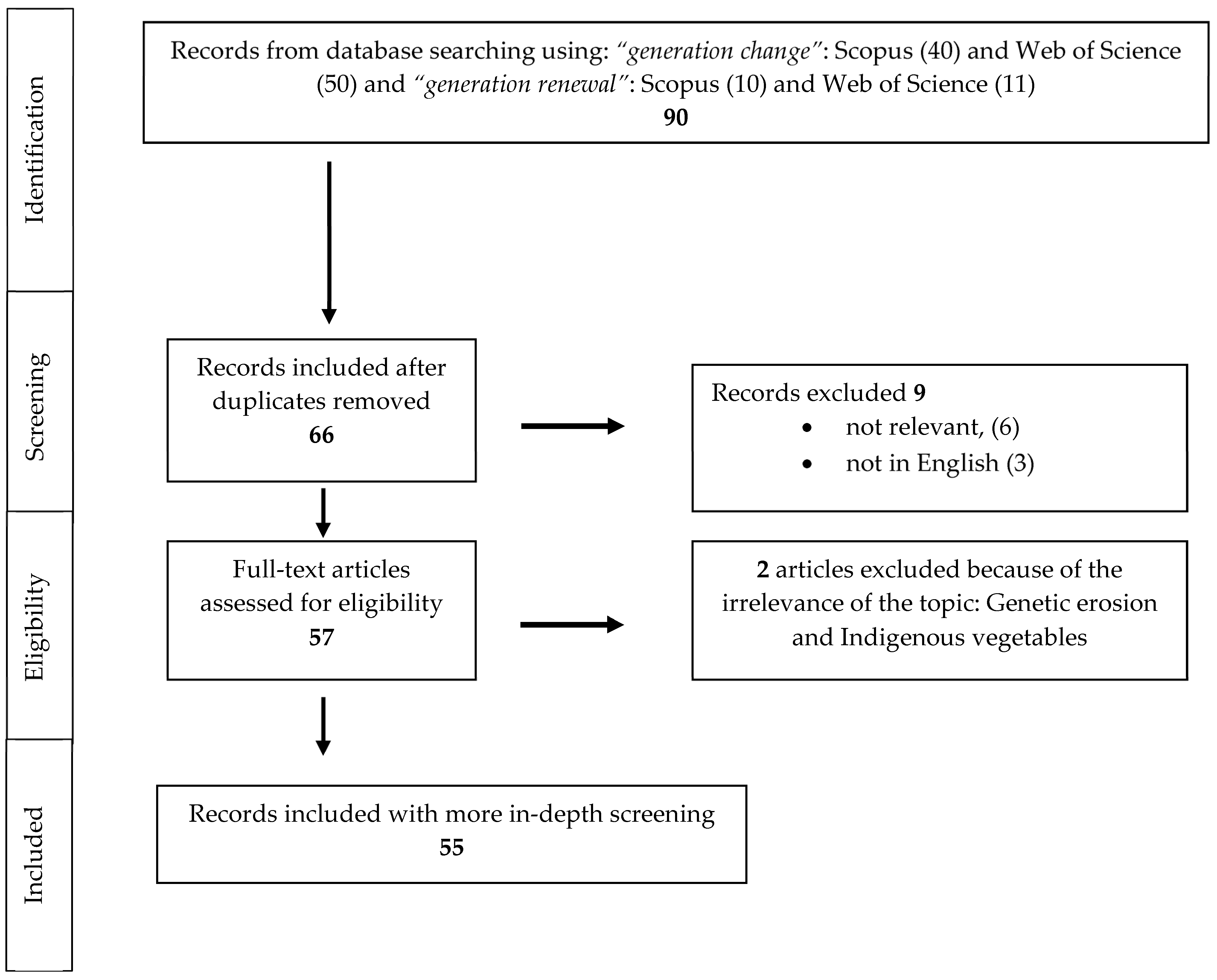
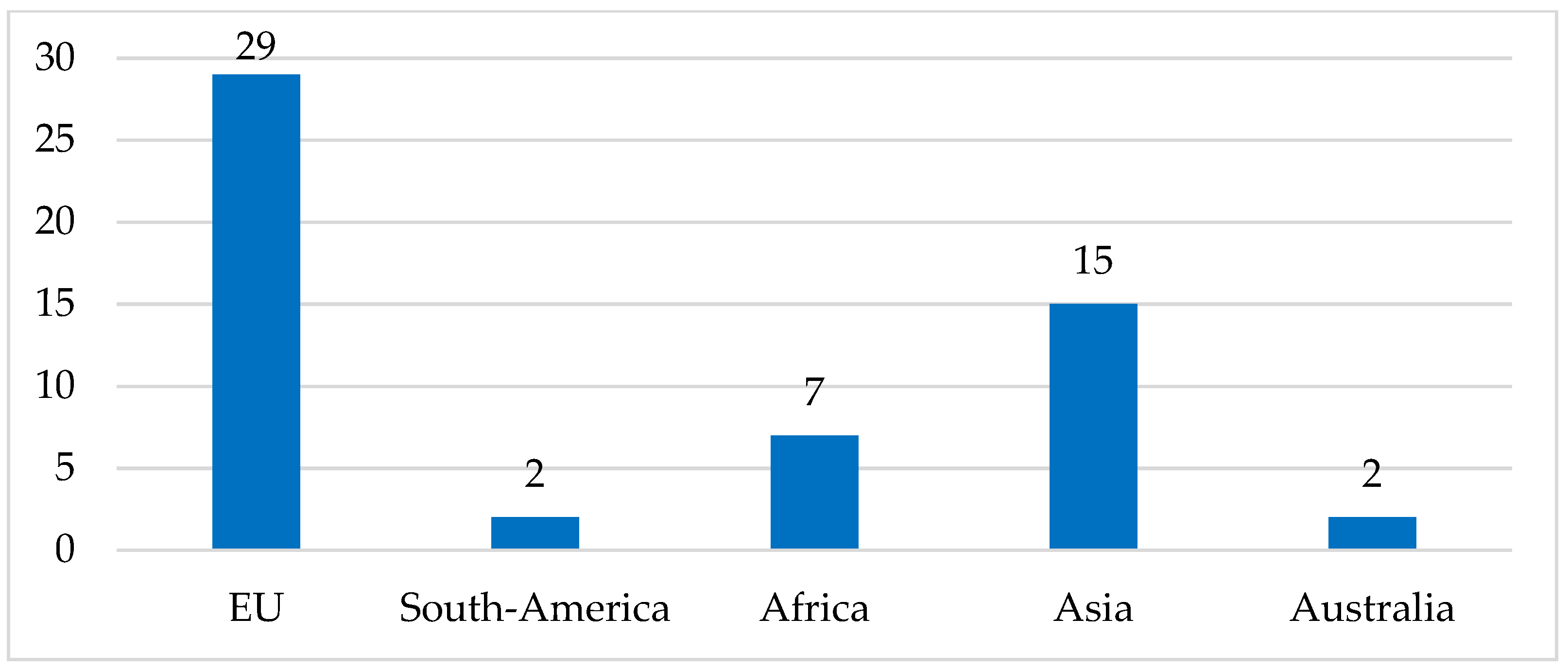
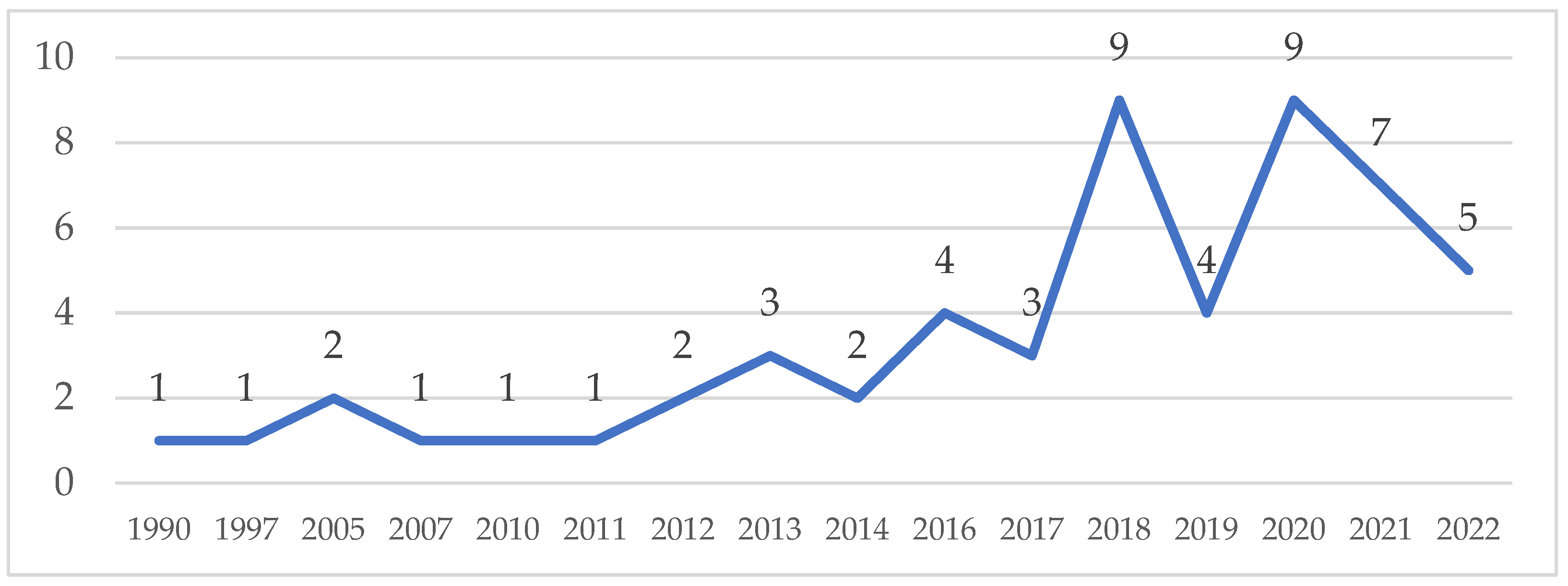
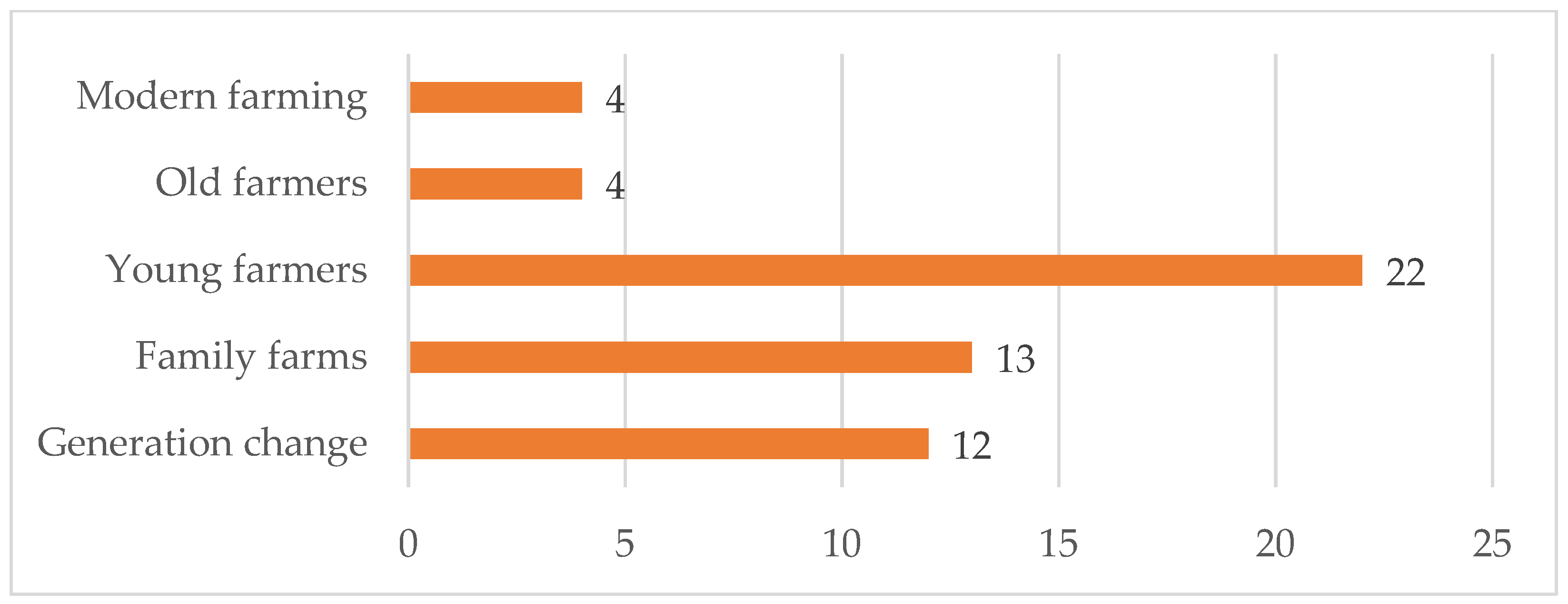
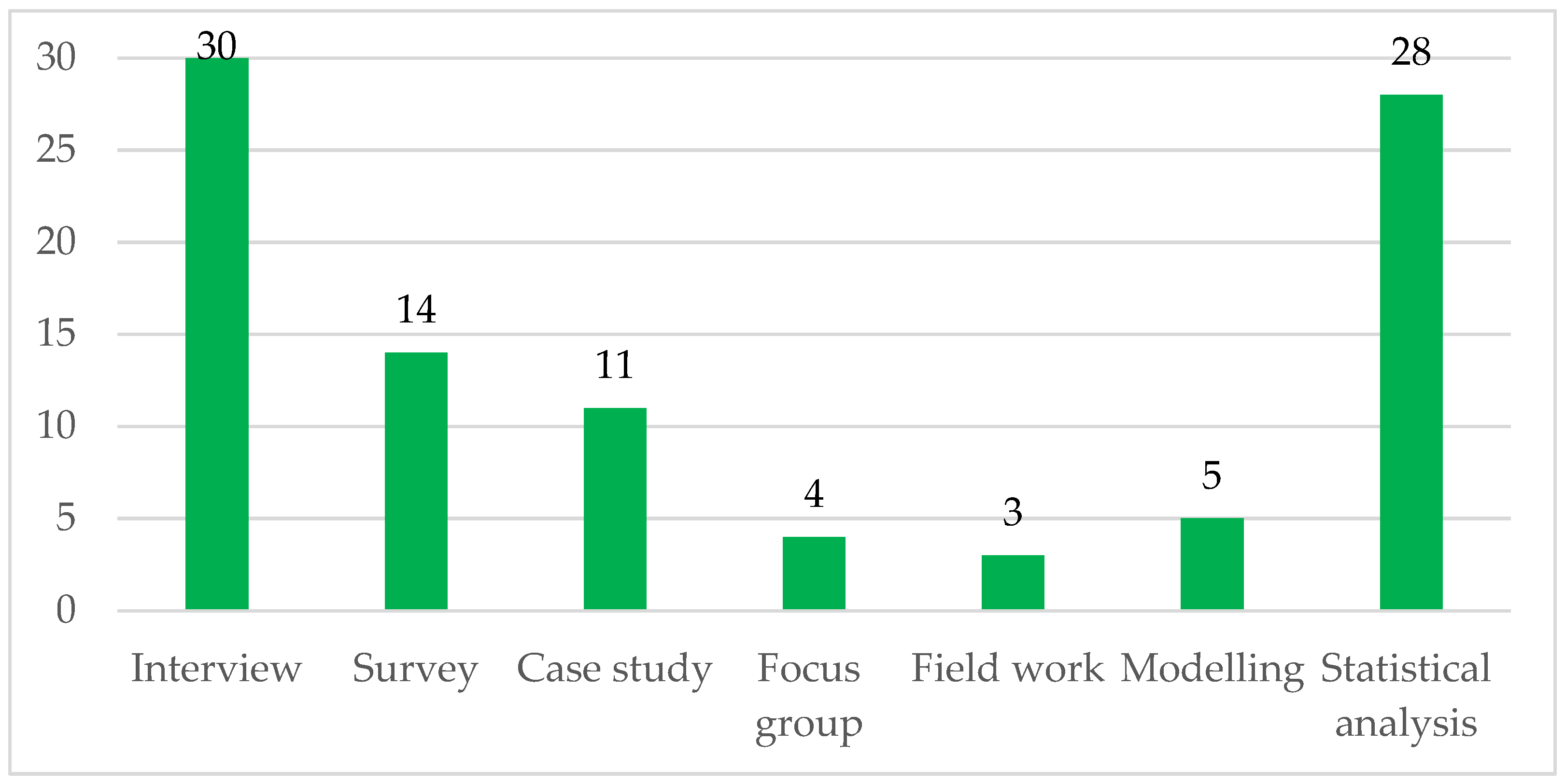
| Supporting Measures | Main Barriers |
|---|---|
| Economic and financial factors | |
|
|
| Education system | |
|
|
| Social and individual factors | |
|
|
Disclaimer/Publisher’s Note: The statements, opinions and data contained in all publications are solely those of the individual author(s) and contributor(s) and not of MDPI and/or the editor(s). MDPI and/or the editor(s) disclaim responsibility for any injury to people or property resulting from any ideas, methods, instructions or products referred to in the content. |
© 2023 by the authors. Licensee MDPI, Basel, Switzerland. This article is an open access article distributed under the terms and conditions of the Creative Commons Attribution (CC BY) license (https://creativecommons.org/licenses/by/4.0/).
Share and Cite
Borda, Á.J.; Sárvári, B.; Balogh, J.M. Generation Change in Agriculture: A Systematic Review of the Literature. Economies 2023, 11, 129. https://doi.org/10.3390/economies11050129
Borda ÁJ, Sárvári B, Balogh JM. Generation Change in Agriculture: A Systematic Review of the Literature. Economies. 2023; 11(5):129. https://doi.org/10.3390/economies11050129
Chicago/Turabian StyleBorda, Áron József, Balázs Sárvári, and Jeremiás Máté Balogh. 2023. "Generation Change in Agriculture: A Systematic Review of the Literature" Economies 11, no. 5: 129. https://doi.org/10.3390/economies11050129
APA StyleBorda, Á. J., Sárvári, B., & Balogh, J. M. (2023). Generation Change in Agriculture: A Systematic Review of the Literature. Economies, 11(5), 129. https://doi.org/10.3390/economies11050129








